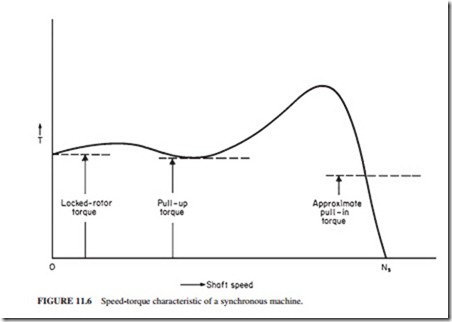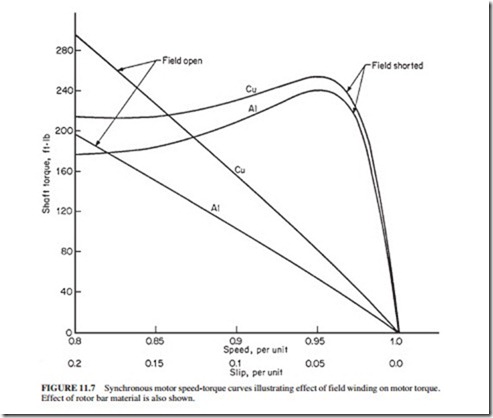TORQUE TESTS
Some torque values are important for a synchronous machine. They include the following:
1. Locked-rotor torque: This is the torque developed when the rated voltage and frequency are applied to the motor while the rotor is prevented from turning (Fig. 11.6).
2. Pull-out torque: This is the maximum possible torque developed and sustained at synchronous speed for 1 min when the rated voltage and frequency are applied to the motor.
3. Pull-in torque: This is the maximum constant torque that the motor will develop as it approaches the synchronous speed when the voltage and frequency are applied.
4. Pull-up torque: This is the minimum torque developed during start-up at speeds below the synchronous speed when the rated voltage and frequency are applied to the motor.
5. Speed-torque characteristic: This is the variation of the torque developed by the motor versus the speed when the excitation is not applied to the motor and the rated voltage and frequency are applied to it.
Speed-Torque Characteristic
The tests done to determine the speed-torque characteristic of a synchronous motor are identical to those of an induction motor. However, there are some differences between a synchronous motor and an induction motor. For example, the damper winding of a syn- chronous motor has a much higher resistance than a typical squirrel-cage winding used in an induction motor. The speed-torque characteristic of a synchronous motor depends on the material of the rotor bars and the condition of the field windings, open or closed.
Figure 11.7 illustrates the difference in speed-torque characteristic of a synchronous motor between an open and a shorted field circuit. It also shows the effect of the rotor bar material on the speed-torque characteristic of the motor. Most synchronous machines are designed to start with a shorted (or closed) field.
Pull-In Torque
The pull-in torque is the torque available to pull the rotor into synchronous speed. This characteristic is limited to synchronous machines only. It is difficult to calculate or mea- sure the value of this parameter. It is expressed generally by the nominal pull-in torque, which is the torque developed by the motor at 95 percent of the synchronous speed (Fig. 11.6).
Pull-Out Torque
The pull-out torque is the maximum torque developed by a synchronous machine. It is also a characteristic limited to synchronous machines only. A synchronous machine
(motor or generator) will pull out of synchronous speed when the torque applied exceeds the pull-out torque.

